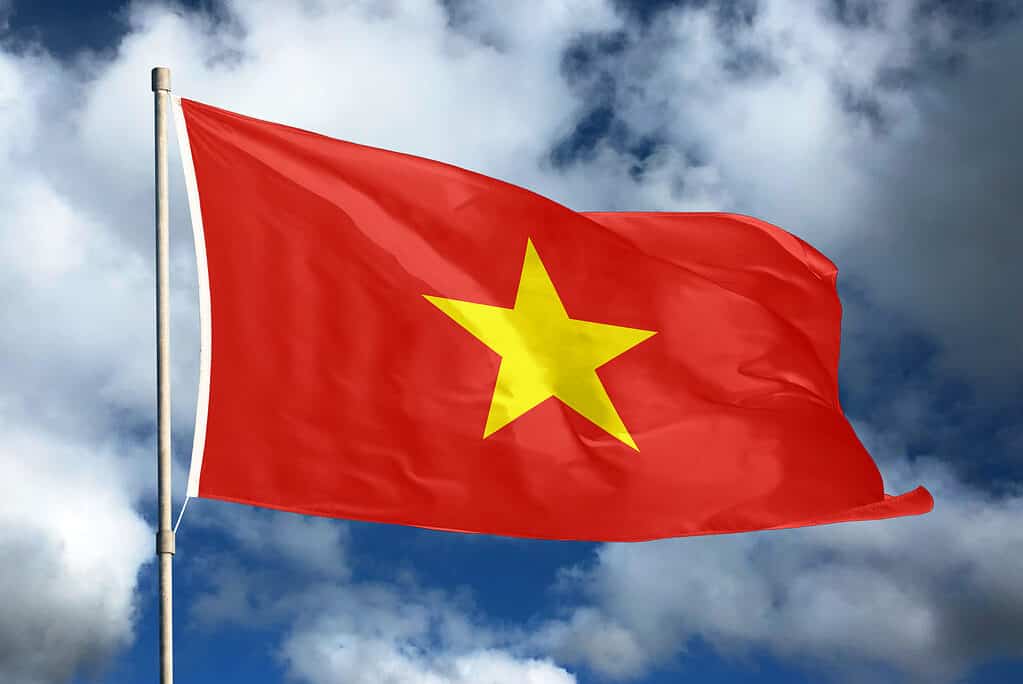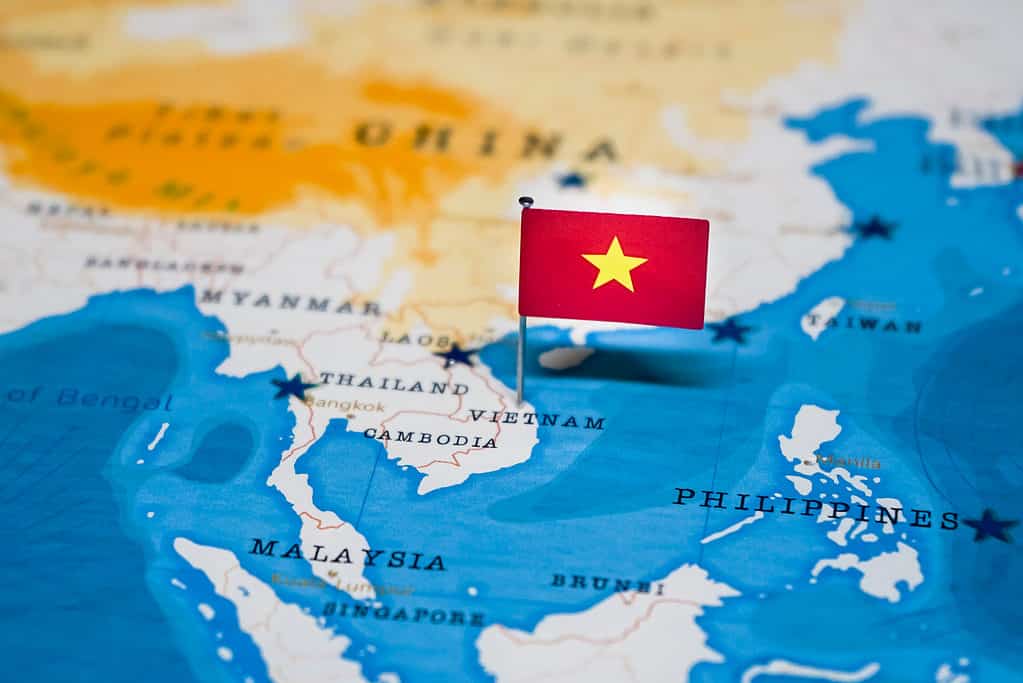Vietnam’s official name is the Socialist Republic of Vietnam. This beautiful country in Southeast Asia is 120,348 square miles in size and has a population of 96 million people. The largest city in Vietnam is Ho Chi Minh City, and the capital city is Hanoi. Like the country itself, the Vietnam flag has a rich cultural history.
Vietnam: Climate and Geography
Vietnam contains hills, dense forests, and over 2,000 miles of coastline. The climate varies widely across the country, from tropical to subtropical. Summer temperatures range from 91°F to 98°F. In the winter, temperatures vary between 37°F to 69°F, depending on the area. Vietnam receives a lot of rain, averaging between 59-79 inches during the monsoon season. The country is experiencing many negative changes due to climate change and rising water levels, as more than half of the population lives near coastal areas.
Vietnam: Economy, Culture, and Cuisine
The dong has been the currency of Vietnam since the late 1970s. The country’s main economy relies on agriculture, namely rice cultivation in wet areas. The country also mines several important minerals, such as bauxite and aluminum. The economy of Vietnam has been steadily improving since the year 2000 thanks to the introduction of trade liberalization, the manufacturing of information technology, and a newly developed oil industry.
Vietnamese is the national and official language of Vietnam, and 70 million people speak it. Other languages spoken in Vietnam are Tày, Mường, Cham, Khmer, Chinese, Nùng, and Hmong. In the Central Highlands area, you can also hear several distinct languages.
Since 1992, the citizens of Vietnam have been able to enjoy the freedom of religion. In a 2019 survey, 86 percent of Vietnamese identified with a folk religion or had no religious affiliation.
The food in Vietnam is spicy, sour, bitter, salty, and sweet. The cuisine is fresh and full of herbs and vegetables. It is often named the healthiest cuisine in the world.
Flag of Vietnam: Description

The Vietnam flag features a yellow star and red background.
©Tatohra/Shutterstock.com
The flag of Vietnam is a bright red background showing a yellow five-point star directly in the middle.
The People’s Army of Vietnam uses the same flag with the yellow words Quyết thắng (Determining to win) in the upper canton. The Vietnam People’s Public Security uses the same flag with the yellow motto Bảo vệ an ninh Tổ quốc (Protecting the security of the Fatherland) in the upper canton.
Flag of Vietnam: Symbolism
The flag’s red background symbolizes revolution and bloodshed, as well as the struggle and success of the people. The star’s five points stand for the five classes in Vietnamese society – intellectuals, farmers, workers, traders, and soldiers.
Flag of Vietnam: History

South Vietnam adopted the same flag as North Vietnam after the country unified in 1976.
©Hyotographics/Shutterstock.com
Citizens originally designed the flag in 1940 during an uprising against the French led by the people of southern Vietnam. A communist-led group called Viet Minh used it in 1941 to oppose the Japanese occupation.
When Vietnam became independent at the end of World War II, the leader of Viet Minh (Ho Chi Minh) adopted the flag as the national flag of the Democratic Republic of Vietnam (DRV). The DRV was the ruling government in North Vietnam until 1954. South Vietnam flew a yellow flag with three red stripes until the end of the Vietnam war (1975) but adopted the same flag as North Vietnam after Vietnam unified in 1976. People sometimes combine the national flag with the flag of the Communist Party of Vietnam.
Flag of Vietnam: Variations
Vietnam has had many dozens of political, religious, military, and cultural flags over the years. You can view a complete list here. Currently, the red flag with a golden star and the diasporic flags are the most common.
The diasporic flag consists of a yellow field with three horizontal red stripes across the middle. The three red stripes represent the common blood running through northern, central, and southern Vietnam. The people who most commonly fly this flag are the 4.5 million Vietnamese living overseas.
Vietnam: Reunification Day
This important holiday in Vietnam is also called Victory Day and Liberation Day, though the official name is The Day of Southern Liberation for National Reunification. This holiday marks the day that Northern Vietnam and Viet Cong forces captured Saigon on April 30th, 1975. The nation celebrates it every year on the same day, commemorating the end of the Vietnam War and the start of the merging of South and North Vietnam into one unified country. Vietnamese living in overseas communities call this holiday the Fall of Saigon or Black April. It is a day of reflection and remembrance of the many sacrifices of all who were affected by the war.
Vietnam: National Day
On September 2nd, 1945, President Ho Chi Minh read the Declaration of Independence of Vietnam in Hanoi. Citizens now celebrate this day yearly as National Day in Vietnam. The Communist Party of Vietnam (the government of a united Vietnam) established the original list of national holidays. The list was revised in 2007, but National Day was kept as a full bank and public holiday. In 2019, the government lengthened it to a two-day holiday.
NEXT UP:
- The Flag of the United States of America: History, Meaning, and Symbolism
- Discover the Largest Snake Found in Vietnam
- Discover the 10 Oldest Countries in the World
The photo featured at the top of this post is © Paisan Changhirun/Shutterstock.com
Sources
- Vietnam, Available here: https://vietnamnet.vn/chinh-thuc-bo-sung-1-ngay-nghi-le-dip-quoc-khanh-29-589956.html
- CRW Flag, Available here: https://www.crwflags.com/fotw/flags/vn-svprs.html
- Web Archive, Available here: https://web.archive.org/web/20131007001502/http://www.vietnamonline.com/culture/national-flag.html
- moj.gov, Available here: https://moj.gov.vn/Pages/home.aspx
Thank you for reading! Have some feedback for us? Contact the AZ Animals editorial team.






